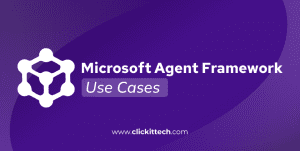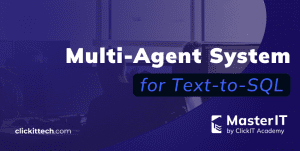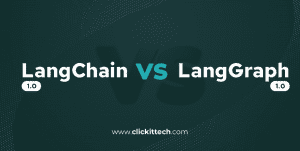Businesses are aggressively embracing ChatGPT integration services to empower their digital ecosystem with capabilities such as consulting, custom development, customer service, security audit, ongoing maintenance, and many more.
ChatGPT integration services embed ChatGPT models into customer-facing applications, business systems, and workflows. These services infuse natural language capabilities into business systems, bringing raw AI potential and practical business applications onto the same plane.
For instance, we can embed ChatGPT into apps and websites to deliver customer service or integrate it with CRM, ERP, and HR platforms to automate business processes. We can also use APIs and connect ChatGPT to proprietary tools and databases.
- What are the Benefits of Integrating ChatGPT into your Apps?
- How to Integrate ChatGPT into Existing Systems?
- What are the Best Practices for ChatGPT Integration?
- How long does it take to integrate ChatGPT into an existing system?
- ChatGPT Integration Services by ClickIT
- FAQs
What are the Benefits of Integrating ChatGPT into your Apps?
- Operational efficiency to the core. For instance, when you integrate ChatGPT models into content workflows, it automatically creates outlines, FAQs, and full drafts in seconds, which means teams can focus more on high-value creative works.
- Automates sales processes by qualifying leads, answering queries, and pitching personalized quotes to close a deal quickly.
- A striking advantage is personalization. These services go beyond automation and unlock deeper insights and personalization. They analyze past interaction data and predict customer needs to recommend products that are hard for customers to turn down.
- ChatGPT integration services handle workflows 24/7 with lightning speed without requiring additional staff while also improving customer satisfaction. Think about companies that deal with high-volume workloads. This advantage offers high scalability to business processes while reducing costs.
- For startups and SMBs, cost efficiency can be a game-changer. Instead of hiring software staff, a versatile AI can write code, translate languages, or summarize datasets on demand.
- Another benefit is knowledge management. It centralizes organizational knowledge and makes it accessible via conversation
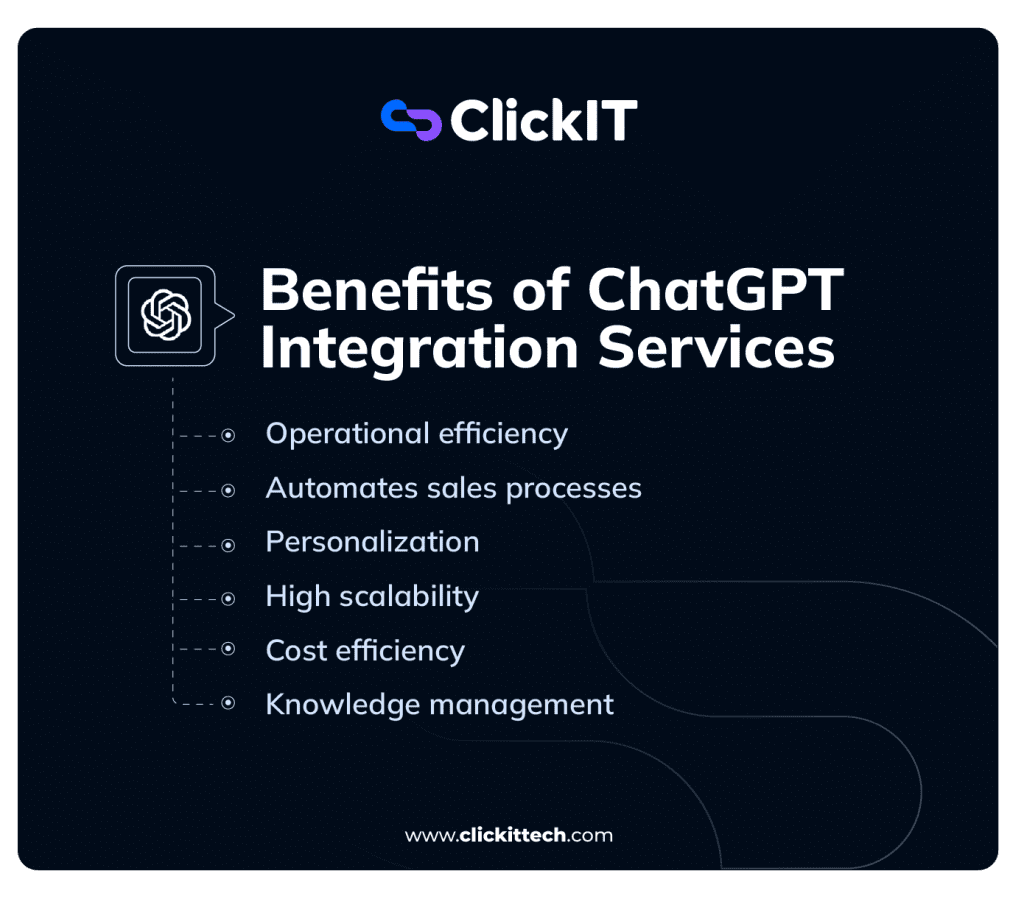
Challenges with ChatGPT Integration Services
There are pain points as well.
- The primary concern is data security and integrity. Companies should consider audit and compliance requirements while sharing sensitive and proprietary information.
- A second concern is accuracy and reliability. There is a risk of hallucinations, outdated or incorrect responses.
- Employees and customers might be hesitant to trust AI responses. Technical challenges while integrating these services with legacy systems cannot be ignored.
- The system should be tuned for domain-specific tasks for effective performance. Organizations should also consider ongoing API fees, maintenance, and infrastructure scaling costs.
Read our blog, Claude vs GPT
How to Integrate ChatGPT into Existing Systems?
This section provides practical, step-by-step guidance on how to integrate ChatGPT to achieve seamless integration across your core services.
1 Step. ChatGPT API Integration
The first step is to configure secure HTTP/JSON endpoints within the existing system to communicate with the OpenAI API.
These endpoints send dynamic prompts and receive generated text responses in real time, enabling seamless conversational capabilities. It turns your app into an AI-enhanced powerhouse without overhauling the infrastructure.
You can obtain an OpenAI API key from the OpenAI website:
You can use the Chat Completions endpoint (https://api.openai.com/v1/chat/completions) via a POST request.
Here is a Python example using the OpenAI SDK:
import openai
import os
openai.api_key = os.getenv("OPENAI_API_KEY")
response = openai.chat.completions.create(
model="gpt-4o",
messages=[
{"role": "system", "content": "You are a helpful assistant."},
{"role": "user", "content": "Summarize the latest AI trends."}
],
temperature=0.7,
max_tokens=150
)
print(response.choices[0].message.content)
Expose an endpoint in your backend via Express.js or Flask and integrate this into your system. The API gets triggered on user actions like form submissions.
2 Step. Middleware and Context Mapping (GPT Integration into Existing Products)
This step involves building a dedicated middleware layer that bridges the existing product interface with ChatGPT.
This middleware layer maps a product’s native UI action, such as a button click, text input, or event trigger, to a context-aware API call to GPT, enriching the core features of the product. It acts as an intermediary, handling data transformation, authentication, and orchestration between your legacy systems and OpenAI’s API.
To do so, perform an audit of your product’s stack and identify entry points like user inputs or database queries.
You can use tools like Node.js with Express for the middleware, or Python’s FastAPI for async handling. Before calling the API, the layer should enrich prompts with context. For instance, it can pull out the user history from your CRM and then post-process outputs for integration back into your UI.
Here is an example middleware in Node.js:
const express = require('express');
const OpenAI = require('openai');
const app = express();
app.use(express.json());
const openai = new OpenAI({ apiKey: process.env.OPENAI_API_KEY });
app.post('/gpt-query', async (req, res) => {
const { userInput, context } = req.body;
const prompt = `Context: ${context}\nUser: ${userInput}`;
const response = await openai.chat.completions.create({
model: 'gpt-4o',
messages: [{ role: 'user', content: prompt }]
});
res.json({ reply: response.choices[0].message.content });
});
app.listen(3000, () => console.log('Middleware running'));3 Step. GPT Application Development for Full-stack Architecture Design
Advanced ChatGPT integration services imply designing a full-stack architecture with ChatGPT as the core processing engine.
It orchestrates data flow, manages conversational logic, and interacts dynamically with various application components. This creates standalone or hybrid apps with GPT at the core while ensuring smooth integration between backend systems and user interfaces.
Here is an example of a full-stack setup:
- Architecture: Microservices architecture
- Frontend: React / Vue
- Backend: Node.js / Django
- Service Layer: GPT
- Database: Database integration via PostgreSQL with vector extensions for embeddings enables semantic search.
- API: LangChain for chaining API calls and managing state in conversations.
For this example, consider React as the frontend that captures input and displays responses:
import React, { useState } from 'react';
import axios from 'axios';
function ChatApp() {
const [message, setMessage] = useState('');
const [reply, setReply] = useState('');
const sendMessage = async () => {
const res = await axios.post('/api/chat', { message });
setReply(res.data.reply);
};
return (
<div>
<input value={message} onChange={e => setMessage(e.target.value)} />
<button onClick={sendMessage}>Send</button>
<p>{reply}</p>
</div>
);
}
The backend routes to GPT, with orchestration. Incorporate containerization with Docker and orchestration via Kubernetes for scalability.
4 Step. Voice and Multimodal Integration
For applications that involve voice or multimedia interaction, Speech-to-Text (STT) and Text-to-Speech (TTS) APIs are integrated with the GPT service.
This enables real-time audio processing and spoken responses. Optionally, image and video analysis pipelines can also be connected to extend the system’s multimodal intelligence for delivering immersive, hands-free experiences.
For STT and TTS, we can use OpenAI’s Whisper:
- Speech-to-Text: /v1/audio/transcriptions
- Text-to-Speech: /v1/audio/speech
For multimodal, leverage GPT-4o’s vision capabilities by passing base64-encoded images in prompts.
Here is the integration flow:
- Capture audio via Web Audio API.
- Transcribe with Whisper.
- Process with GPT-4o (include image URLs if multimodal).
- Synthesize response with TTS.
Here is a Python code example for Voice:
import openai
import io
from pydub import AudioSegment
# Transcribe audio file
with open("audio.mp3", "rb") as audio_file:
transcript = openai.audio.transcriptions.create(
model="whisper-1",
file=audio_file
)
# GPT process
response = openai.chat.completions.create(
model="gpt-4o",
messages=[{"role": "user", "content": transcript.text}]
)
# TTS
tts_response = openai.audio.speech.create(
model="tts-1",
voice="alloy",
input=response.choices[0].message.content
)
tts_response.stream_to_file("output.mp3")
You use Flutter for cross-platform voice UI for apps.5 Step. Custom Model Fine-Tuning and Training
For model fine-tuning and training, upload proprietary data to OpenAI’s fine-tuning service. The resulting specialized model is optimized for domain-specific knowledge and can be accessed via a unique API endpoint.
This ensures accuracy and contextual depth in responses.
Here is an example workflow:
- Prepare JSONL datasets.
Eg: {“messages”: [{“role”: “user”, “content”: “Query”}, {“role”: “assistant”,
“content”: “Response”}]}).
- Upload via API
- Create a fine-tuning job
- Monitor progress.
Once ready, use the model ID in completions calls.
Here is a CLI example on Bash:
openai api fine_tunes.create -t data.jsonl -m gpt-4o-mini6 Step. AI Audit, Governance, and Security Assessment
Implementing data sanitation checkpoints is important in integration. This will anonymize sensitive information before transmission to the API. Robust logging and monitoring protocols are also established to ensure transparency, compliance, and moderation of all AI interactions.
This involves building governance with cross-functional teams, policies for usage, and tools like Sentry for monitoring. Also, sanitize with regex to strip PII. Use encryption (HTTPS) and audit trails.
What are the Best Practices for ChatGPT Integration?
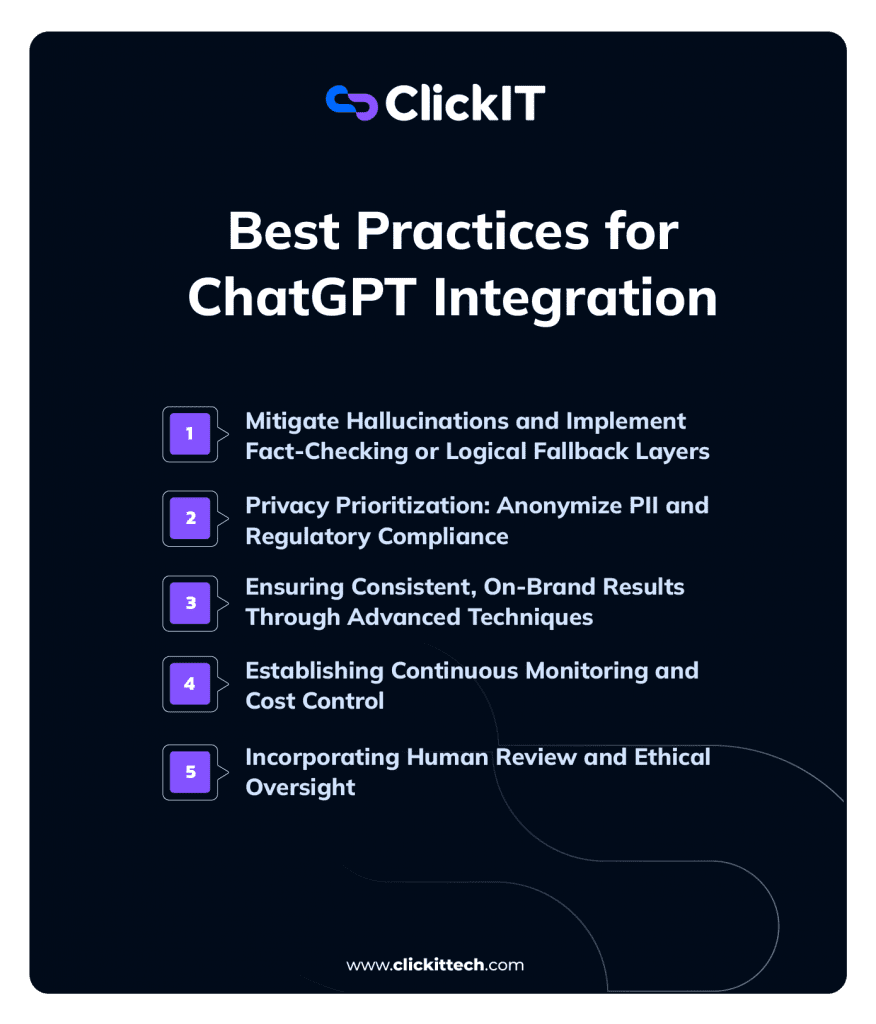
Mitigate Hallucinations and Implement Fact-Checking or Logical Fallback Layers
Dealing with hallucinations is a big challenge with ChatGPT. To mitigate hallucinations, configure response filters, knowledge-grounding mechanisms, and prompt constraints. For instance, implement Retrieval-Augmented Generations (RAG) techniques, which enable the model to pull data from verified external sources before responding.
Additionally, implement a validation layer and make all GPT responses pass through the layer. This layer will cross-check facts against trusted databases or business rules. In case of uncertainty, the system should fall back to a predefined message or escalate to a human agent.
Privacy Prioritization: Anonymize PII and Regulatory Compliance
Data privacy is non-negotiable and integrations should adhere to regulations such as HIPAA, GPR, or CCPA. To protect user privacy, mask or anonymize Personally Identifiable Information (PII) such as names, contact details, and identifiers before transmission of this data to the GPT API. This will also reduce compliance exposure.
Implement preprocessing pipelines to redact names, addresses, or emails using libraries like SpaCy or regex. Replace this data with placeholders to prevent unintended data exposure. Maintain transparent consent, data minimization, and audit trails as well.
Ensuring Consistent, On-Brand Results Through Advanced Techniques
Structured, context-rich prompts lead to more accurate and relevant outputs. Include background, intent, and format expectations in your prompts to achieve consistent, task-specific results.
For example, a healthcare brand might train the model on past patient interactions to generate empathetic, health issue-focused replies. Augment this with system prompts that enforce guidelines such as responding in a professional, concise manner using your brand voice.
Implement output validation layers for functional quality and keyword checks for brand alignment. Performing sentiment analysis via Hugging Face models helps in delivering positivity and neutrality.
Establishing Continuous Monitoring and Cost Control
Establish continuous monitoring by integrating monitoring dashboards to track usage, performance, and anomalies. You can use tools like Prometheus or OpenAI’s usage API to track metrics. User feedback loops help you in determining response accuracy.
With automated alerts and analytics, you can detect drift, bias, or irregular behavior early. For instance, ethical flags like biased languages can be identified using libraries like Fairlearn. This will help in maintaining high service reliability.
To optimize operational costs, control API usage through caching frequent responses, set usage limits, and choose optimal model sizes. For simple tasks, go for GPT-3.5 or o4 – mini. When complex reasoning or deep reasoning is involved, GPT-5 or o3 (reasoning) models are the best choice.
By optimizing prompts, you can reduce tokens. Use budgets in OpenAI’s dashboard and set hard limits to cap spending. For high-volume apps, implement a usage quota per user. Regular performance and cost audits will keep the integration financially sustainable.
Incorporating Human Review and Ethical Oversight
Critical or high-impact outputs like legal advice should always include a human-in-the-loop review. Implement escalation mechanisms for seamless transfer from AI to human agents when context, empathy, or complex reasoning is required.
Ensure that AI outputs are ethical, transparent, and inclusive. Conduct periodic audits to eliminate harmful, biased, or manipulative content generation so that both functional quality and user trust are maintained.
How long does it take to integrate ChatGPT into an existing system?
How long does it take to integrate ChatGPT into an Existing System?
GPT Integration timelines depend on system complexity, use case, and integration approach.
| ChatGPT Integration Services | Purpose | Tasks Involved | Timeline |
| Basic ChatGPT API Integration (Simple Endpoints) | Setting up secure HTTP/JSON endpoints to send prompts and receive responses | Configuring API keys, writing basic API calls using Python or Node.js, and testing in a sandbox like OpenAI’s Playground | 1-2 weeks ( Adding a chatbot to a website takes 3-5 days. |
| Middleware for Existing Products | Building a middleware layer to map UI actions to context-aware API calls | Auditing the tech stack, integrating with databases or CRMs, and optimizing for latency with caching | 2-4 weeks Complex systems with legacy code may take 4-6 weeks |
| Full-Stack GPT Application Development | Designing a new app with ChatGPT as the core engine | Frontend (React), backend (FastAPI), and orchestration (LangChain), plus containerization for scalability | 4-8 weeks |
| Voice and Multimodal Integration | Adding Speech-to-Text, Text-to-Speech, or vision capabilities | Capturing audio via Web Audio API, transcribing it with Whisper, processing text and optional image/video inputs with GPT model etc. | 3-6 weeks |
| Compliance | AI Audit and Security Setup | Implementing data sanitation, logging, and compliance checks | 2-4 weeks for initial setup, with ongoing monitoring |
ChatGPT Integration Services by ClickIT
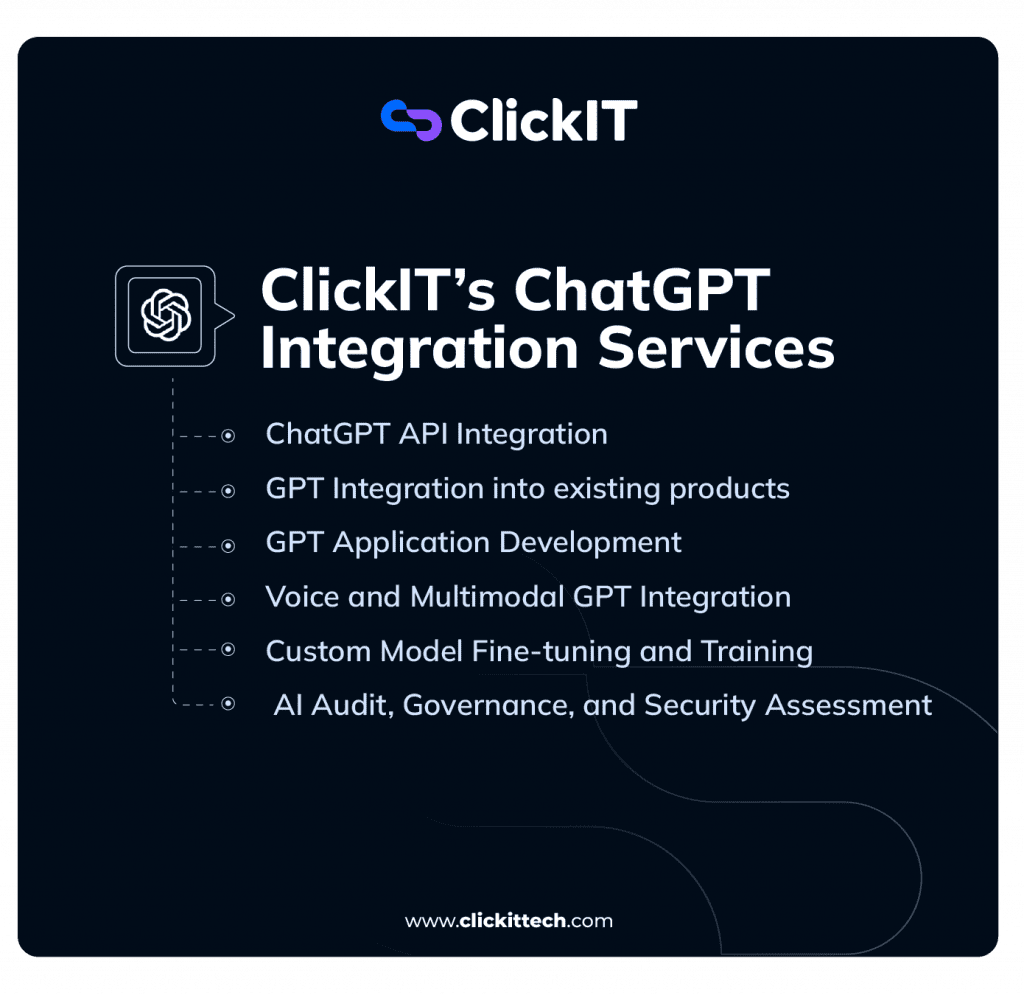
As a pioneer in AI Development Services, ClickIT delivers customized ChatGPT integration services designed to take your business forward.
Backed by years of expertise with OpenAI’s ecosystem, our highly experienced team handles all the complexities of the deployment while you focus on innovation. It is not just about straightforward API Hooks.
Our offerings ensure your integrations are functional, secure, scalable, and align with your branding.
Here are the key ChatGPT integration services offered by ClickIT that are designed based on proven methodologies and real-world results.
Start your ChatGPT integration journey with certified AI LATAM developers from ClickIT. Book a Call
a) ChatGPT API Integration
We help organizations integrate the ChatGPT API into their existing systems, workflows, and apps for delivering seamless automation, conversational interfaces, and intelligent task execution within business processes.
This process involves:
- API Key Provisioning and Authentication
- Prompt Engineering
- Error Handling and Logging
b) GPT Integration into existing products
We help organizations embed GPT capabilities into existing CRM, HR, Mobile Support, or Customer Service platforms for enhanced user interaction, repetitive process automation, and improved decision support.
Key steps involved in this process:
- Compatibility Audit
- Hybrid Workflows
- Performance Optimization
c) GPT Application Development
Be it intelligent assistants and content generators or domain-specific knowledge tools tailored to each client’s industry needs, we design and build end-to-end applications powered by ChatGPT.
Our methodology emphasizes:
- Agile Sprints
- Scalability features
- Monetization hooks
d) Voice and Multimodal GPT Integration
With ChatGPT, it’s not just about text. We extend its capabilities by integrating voice recognition, image understanding, and multimodal interactions. These speech-based and visual interfaces create a more natural, human-like experience for users.
Key aspects of our implementation
- End-to-end pipeline
- Cross-platform support
- Accessibility enhancements

e) Custom Model Fine-tuning and Training
To make GPT truly yours, our team of experts fine-tunes GPT models using domain-specific data. This will ensure accuracy, relevance, and brand alignment while adhering to compliance requirements and organization goals.
The workflow involves:
- Data Pipeline
- Hyperparameter Tuning
- Deployment and A/B Testing
f) AI Audit, Governance, and Security Assessment
Don’t worry about rising AI risks. Our AI Audit, Governance, and Security Assessment service builds a fortress around your deployment. We perform comprehensive assessments to ensure safe, ethical, and compliant AI usage.
This includes auditing AI behavior, data handling, bias detection, and adherence to security and governance frameworks.
Core components include:
- Risk Mapping
- Governance Frameworks
- Remediation Roadmap
Ready to integrate ChatGPT into your product? Hire ClickIT’s LATAM AI engineers and have a team in 3 days!
FAQs
To scale ChatGPT integrations cost-effectively, balance performance, usage volume, and model selection.
Start by deploying lightweight models for routine or low-complexity tasks, and reserve higher-capacity reasoning models for advanced queries.
Implement request routing logic that automatically identifies query complexity and assigns it to the most suitable model.
Use key performance indicators (KPIs) like response accuracy, user satisfaction, resolution time, cost per interaction, and reduction in human support workload. Continuous monitoring and A/B testing track improvements while optimizing performance.
Yes. ChatGPT can connect with legacy systems through middleware or API gateways. These intermediaries will translate internal data formats into API-compatible requests.
This allows companies to modernize workflows and deliver AI-driven experiences without overhauling their existing IT infrastructure.



